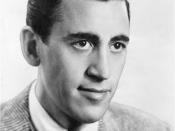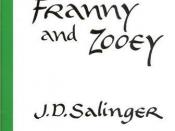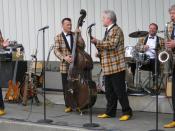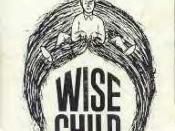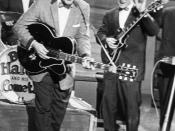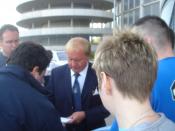Franny and Zooey Fifty Years Later - Show how the book is now dated.
The dictionary defines dated as ÃÂto show the age of; show to be old-fashioned.ÃÂ J.D. SalingerÃÂs two-part story, Franny and Zooey, considered so modern and ÃÂperhaps the best book by the foremost stylist of his generation,ÃÂ fifty years after itÃÂs original publication, now seems dated. Both the simplicity of the central charactersÃÂ emotional turmoil and the cultural references to food, smoking, technology, religion and entertainment make the story seem quaint and old-fashioned.
In the first section of the book, Franny, the title character is visiting her boyfriend, Lane, at his Ivy League college for a football weekend. The clothes, the language, the food andLaneÃÂs arrangements for the weekend all seem to place the story in a much earlier time. He wears a camelÃÂs hair coat and a cashmere muffler and Franny is wearing a sheared raccoon coat.
She writes a letter to Lane, which he has saved, calling him ÃÂdearest LaneÃÂ and the letter is typed and mailed. They go to a restaurant for lunch and order martinis, escargot and frogs legs and both smoke cigarettes throughout the entire meal. Lastly, theyÃÂre invited to a pre-game cocktail party and he has reserved a room for her in some kind of boarding house. None of these things seem at all like a contemporary college experience where email, jeans, a tailgate party and spending the weekend together would be expected.
FrannyÃÂs nervous breakdown and all the family activity that happens as a result also seem quaint. Franny faints in the restaurant with Lane and then, the next day, finds herself at home wrapped in an afghan in her families New York apartment. Franny is upset by what she sees as the phoniness of the people she knows and the college she is attending. She is searching for spirituality and is obsessed with a small book called ÃÂThe Way of the Pilgrimàand the ÃÂJesus Prayer.àIn this day and age this sort of behavior seems more like a bad day or an identity crisis than a nervous breakdown. In our time we expect to see much more self-destructive behavior, cutting, drugs, eating disorders or violence. It is also strange that she would turn to her family and that they would see it as their job to cure her. Now, it would be more likely that Franny and her family would turn to a therapist, a hospital or some sort of clinical solution to FrannyÃÂs breakdown. It is very nice that Zooey, FrannyÃÂs younger brother, after some false starts, at the end finds the right story and words to improve the situation but it seems like a naïve conclusion.
Franny is upset over everyoneÃÂs desire to be alike. In their lunch at the beginning of the book Lane is pleased with himself for ÃÂfinding himself in the right place with an unimpeachably right looking girl.ÃÂ (Salinger 11) Franny notices this and it annoys her.
The 1950s, the time when this story takes place, are known for being a time of conformity and this is part of what Franny is rebelling against. The issue of celebrity is another part of this. Franny, Zooey and their 5 brother s and sisters were all well known as contestants on a radio show called The Wise Child. The public considered them to be ÃÂinsufferably superior little bastardsÃÂ or bone-fide underage wits and savants, of an uncommon, if unenviable, order.ÃÂ (Salinger 54) Both Franny and Zooey both continue to be in the public eye. Zooey is a TV actor and Franny is active in college and summer stock theater. Both of these characters see how entertainment is conformist and it makes them both uncomfortable. Again, all of this seems to make this story seem old-fashioned. The Glass childrenÃÂs celebrity seems so small in comparison with the cult of celebrity that we live with today. Who can even remember the name of someone who wins Who Wants to be a Millionaire or Jeopardy, todayÃÂs equivalent of The Wise Child.
The cigarettes in "Franny and Zooey,ÃÂ may date this work more than any other single aspect of the story. Every character is the book beginning with Lane and Franny, the older Glass children in flashbacks, their mother Bessie and Zooey all smoke continuously through the book. There are cigarettes, lit, ignored, smoked, stomped out, carried, and used for emphasis in almost every scene. ZooeyÃÂs cigar, the hunt for matches, the cigarette burns in Buddy and SeymourÃÂs desks are all smoking-related images in this story. In contemporary life cigarettes almost only have negative connotations and in contemporary writing it is almost only the bad guys who smoke.
In our time where religion is often used as a political tool, a social status symbol or a reason for war it is interesting to see religion in ÃÂFranny and ZooeyÃÂ used as a path to a personal understanding. In many contemporary situations religion is a very public thing. There are mega churches, religious programs on TV and politicians using the Christian Conservative movement as their base. In this story both Franny and Zooey have been taught much about many different religions and Franny is trying to use the ÃÂJesus PrayerÃÂ to help her find her personal way and place in the world.
Throughout ÃÂFranny and ZooeyÃÂ the culture of the 1950ÃÂs is a central part of the story. The use of typewriters, the foods that they eat, the smoking, and the radio celebrities are all specific to that earlier time. The larger issues of conformity and the characters personal relationship with religion are also very different than contemporary culture. Overall the Glass family, although all very intelligent and in the middle of a crisis, seem very unsophisticated. Franny and Zooey is well written and fun to read with its dramatic characters and 50ÃÂs slang but when read in 2006 it seems dated.
SourcesÃÂFranny and Zooey.ÃÂ Books of he Times. September 14, 1961. ÃÂDated.ÃÂ About Dictionary.com. 2006. accessed: October 21, 2006. Salinger, J.D. Franny and Zooey. New York, New York: Back Bay Books, 1955
